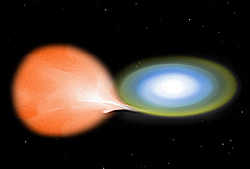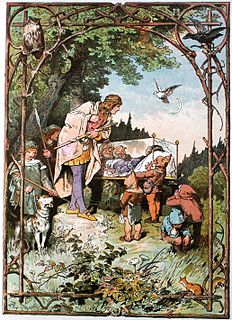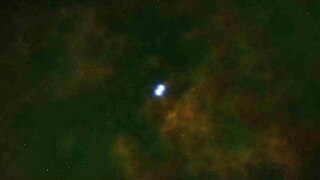
A nova or classical nova is a transient astronomical event that causes the sudden appearance of a bright, apparently "new" star, that slowly fades over several weeks or many months.

Snow White and the Seven Dwarfs is a 1937 American animated musical fantasy film produced by Walt Disney Productions and originally released by RKO Radio Pictures. Based on the German fairy tale by the Brothers Grimm, it is the first full-length cel animated feature film and the earliest Disney animated feature film. The story was adapted by storyboard artists Dorothy Ann Blank, Richard Creedon, Merrill De Maris, Otto Englander, Earl Hurd, Dick Rickard, Ted Sears and Webb Smith. David Hand was the supervising director, while William Cottrell, Wilfred Jackson, Larry Morey, Perce Pearce, and Ben Sharpsteen directed the film's individual sequences.

"Snow White" is a 19th-century German fairy tale which is today known widely across the Western world. The Brothers Grimm published it in 1812 in the first edition of their collection Grimms' Fairy Tales. It was titled in German: Sneewittchen and numbered as Tale 53. The name Sneewittchen was Low German and in the first version it was translated with Schneeweißchen. The Grimms completed their final revision of the story in 1854.
A dwarf star is a star of relatively small size and low luminosity. Most main sequence stars are dwarf stars. The term was originally coined in 1906 when the Danish astronomer Ejnar Hertzsprung noticed that the reddest stars—classified as K and M in the Harvard scheme could be divided into two distinct groups. They are either much brighter than the Sun, or much fainter. To distinguish these groups, he called them "giant" and "dwarf" stars, the dwarf stars being fainter and the giants being brighter than the Sun. Most stars are currently classified under the Morgan Keenan System using the letters O, B, A, F, G, K, and M, a sequence from the hottest: O type, to the coolest: M type. The scope of the term "dwarf" was later expanded to include the following:
BPM 37093 is a variable white dwarf star of the DAV, or ZZ Ceti, type, with a hydrogen atmosphere and an unusually high mass of approximately 1.1 times the Sun's. It is about 50 light-years from Earth, in the constellation Centaurus, and vibrates; these pulsations cause its luminosity to vary. Like other white dwarfs, BPM 37093 is thought to be composed primarily of carbon and oxygen, which are created by thermonuclear fusion of helium nuclei in the triple-alpha process.

Warwick Ashley Davis is an English actor, television presenter, writer, director, comedian, and producer. He played the title characters in Willow and the Leprechaun film series, the Ewok Wicket in Star Wars Episode VI: Return of the Jedi and Professor Filius Flitwick and Griphook in the Harry Potter films. Davis also starred as a fictionalised version of himself in the sitcom Life's Too Short, written and directed by Ricky Gervais and Stephen Merchant.
Snow White or Snow White and the Seven Dwarfs is a popular fairy tale.

A type Ia supernova is a type of supernova that occurs in binary systems in which one of the stars is a white dwarf. The other star can be anything from a giant star to an even smaller white dwarf.
The Seven Dwarfs are a group of seven dwarfs that appear in the fairy tale Snow White and others.
Feige 55 is a hot white dwarf approximately 665 light-years away from the Sun in the constellation of Ursa Major. The star is likely a post-AGB star with relatively high luminosity for a standard white dwarf. It is also in a close binary system with orbital period of 1.4933 days.

Seven Dwarfs Mine Train is a steel roller coaster located at Magic Kingdom and Shanghai Disneyland Park. Manufactured by Vekoma, the roller coaster is situated in the Fantasyland sections of both parks. The Magic Kingdom version opened to the public on May 28, 2014, as part of a major park expansion called New Fantasyland, while the Shanghai version opened on June 16, 2016. The ride is themed to Walt Disney's 1937 film Snow White and the Seven Dwarfs, the first traditional-animated feature film.
G 240-72 is a nearby degenerate star of spectral class DQP9.0, located in constellation Draco.

Stein 2051 is a nearby binary star system, containing a red dwarf and a degenerate star, located in constellation Camelopardalis at about 18 ly from Earth.

Snow White and the Huntsman is a 2012 American fantasy film based on the German fairy tale "Snow White" compiled by the Brothers Grimm. The film is the directorial debut of Rupert Sanders, with a screenplay by Evan Daugherty, John Lee Hancock and Hossein Amini, from a screen story by Daugherty. In the film's retelling of the tale, Snow White grows up imprisoned by her evil stepmother, Queen Ravenna, a powerful sorceress. After Snow White escapes into the forest, Ravenna tells Eric, the Huntsman that she will bring back his dead wife if he captures Snow White.

White Dwarf is a 1995 American science fiction television film directed by Peter Markle and starring Paul Winfield, Neal McDonough, CCH Pounder, Beverley Mitchell, David St. James, Ele Keats, and James Morrison. It was written by Bruce Wagner and produced by Francis Ford Coppola, Robert Halmi Sr. and Bruce Wagner for American Zoetrope. Originally intended as a television pilot, the film first aired on the Fox Network on May 23, 1995. While expected to be well received, the film instead garnered generally negative reception. Negative reception notwithstanding, the project received a 1995 ASC Awards nomination for 'Outstanding Achievement in Cinematography'.

A zombie star is a hypothetical result of a Type Iax supernova which leaves behind a remnant star, rather than completely dispersing the stellar mass. Type Iax supernovae are similar to Type Ia, but have a lower ejection velocity and lower luminosity. Scientists think that Type Iax supernovae occur at a rate between 5 and 30 percent of the Ia supernova rate. Thirty supernovae have been identified in this category.













